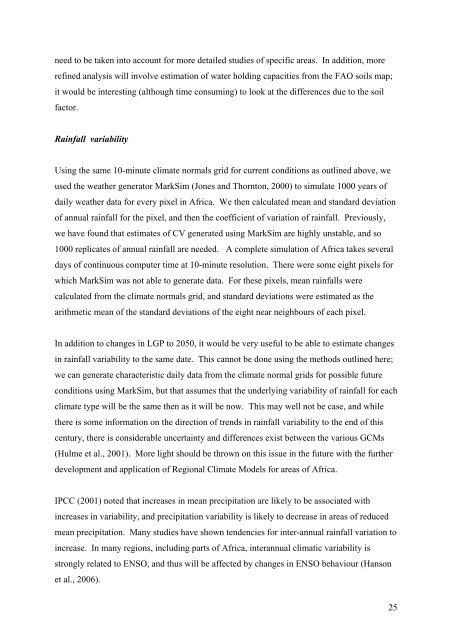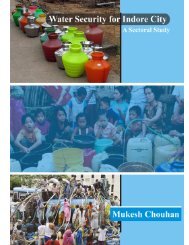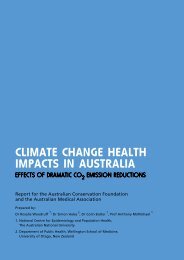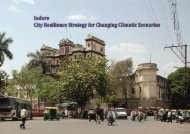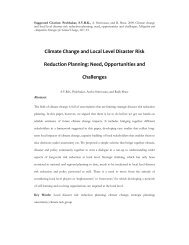Mapping climate vulnerability and poverty in Africa - CGSpace Home
Mapping climate vulnerability and poverty in Africa - CGSpace Home
Mapping climate vulnerability and poverty in Africa - CGSpace Home
Create successful ePaper yourself
Turn your PDF publications into a flip-book with our unique Google optimized e-Paper software.
need to be taken <strong>in</strong>to account for more detailed studies of specific areas. In addition, more<br />
ref<strong>in</strong>ed analysis will <strong>in</strong>volve estimation of water hold<strong>in</strong>g capacities from the FAO soils map;<br />
it would be <strong>in</strong>terest<strong>in</strong>g (although time consum<strong>in</strong>g) to look at the differences due to the soil<br />
factor.<br />
Ra<strong>in</strong>fall variability<br />
Us<strong>in</strong>g the same 10-m<strong>in</strong>ute <strong>climate</strong> normals grid for current conditions as outl<strong>in</strong>ed above, we<br />
used the weather generator MarkSim (Jones <strong>and</strong> Thornton, 2000) to simulate 1000 years of<br />
daily weather data for every pixel <strong>in</strong> <strong>Africa</strong>. We then calculated mean <strong>and</strong> st<strong>and</strong>ard deviation<br />
of annual ra<strong>in</strong>fall for the pixel, <strong>and</strong> then the coefficient of variation of ra<strong>in</strong>fall. Previously,<br />
we have found that estimates of CV generated us<strong>in</strong>g MarkSim are highly unstable, <strong>and</strong> so<br />
1000 replicates of annual ra<strong>in</strong>fall are needed. A complete simulation of <strong>Africa</strong> takes several<br />
days of cont<strong>in</strong>uous computer time at 10-m<strong>in</strong>ute resolution. There were some eight pixels for<br />
which MarkSim was not able to generate data. For these pixels, mean ra<strong>in</strong>falls were<br />
calculated from the <strong>climate</strong> normals grid, <strong>and</strong> st<strong>and</strong>ard deviations were estimated as the<br />
arithmetic mean of the st<strong>and</strong>ard deviations of the eight near neighbours of each pixel.<br />
In addition to changes <strong>in</strong> LGP to 2050, it would be very useful to be able to estimate changes<br />
<strong>in</strong> ra<strong>in</strong>fall variability to the same date. This cannot be done us<strong>in</strong>g the methods outl<strong>in</strong>ed here;<br />
we can generate characteristic daily data from the <strong>climate</strong> normal grids for possible future<br />
conditions us<strong>in</strong>g MarkSim, but that assumes that the underly<strong>in</strong>g variability of ra<strong>in</strong>fall for each<br />
<strong>climate</strong> type will be the same then as it will be now. This may well not be case, <strong>and</strong> while<br />
there is some <strong>in</strong>formation on the direction of trends <strong>in</strong> ra<strong>in</strong>fall variability to the end of this<br />
century, there is considerable uncerta<strong>in</strong>ty <strong>and</strong> differences exist between the various GCMs<br />
(Hulme et al., 2001). More light should be thrown on this issue <strong>in</strong> the future with the further<br />
development <strong>and</strong> application of Regional Climate Models for areas of <strong>Africa</strong>.<br />
IPCC (2001) noted that <strong>in</strong>creases <strong>in</strong> mean precipitation are likely to be associated with<br />
<strong>in</strong>creases <strong>in</strong> variability, <strong>and</strong> precipitation variability is likely to decrease <strong>in</strong> areas of reduced<br />
mean precipitation. Many studies have shown tendencies for <strong>in</strong>ter-annual ra<strong>in</strong>fall variation to<br />
<strong>in</strong>crease. In many regions, <strong>in</strong>clud<strong>in</strong>g parts of <strong>Africa</strong>, <strong>in</strong>terannual climatic variability is<br />
strongly related to ENSO, <strong>and</strong> thus will be affected by changes <strong>in</strong> ENSO behaviour (Hanson<br />
et al., 2006).<br />
25


